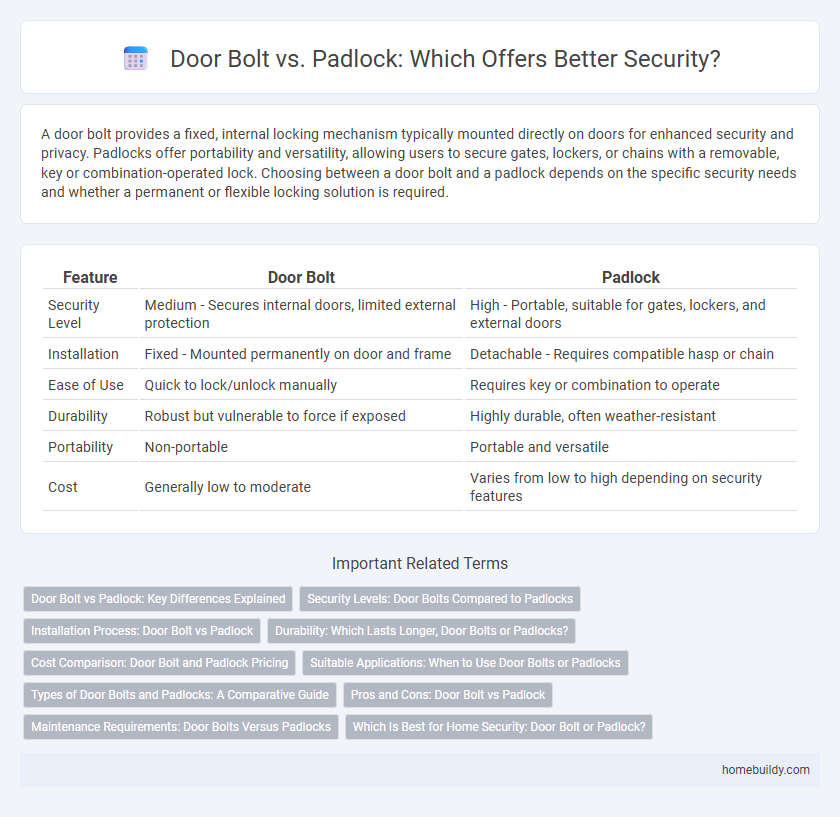A door bolt provides a fixed, internal locking mechanism typically mounted directly on doors for enhanced security and privacy. Padlocks offer portability and versatility, allowing users to secure gates, lockers, or chains with a removable, key or combination-operated lock. Choosing between a door bolt and a padlock depends on the specific security needs and whether a permanent or flexible locking solution is required.
Table of Comparison
| Feature | Door Bolt | Padlock |
|---|---|---|
| Security Level | Medium - Secures internal doors, limited external protection | High - Portable, suitable for gates, lockers, and external doors |
| Installation | Fixed - Mounted permanently on door and frame | Detachable - Requires compatible hasp or chain |
| Ease of Use | Quick to lock/unlock manually | Requires key or combination to operate |
| Durability | Robust but vulnerable to force if exposed | Highly durable, often weather-resistant |
| Portability | Non-portable | Portable and versatile |
| Cost | Generally low to moderate | Varies from low to high depending on security features |
Door Bolt vs Padlock: Key Differences Explained
Door bolts offer direct security by sliding a metal bar into a bracket, providing a fixed barrier ideal for internal and secondary locking. Padlocks rely on a detachable lock mechanism often combined with a hasp, offering portability and flexibility for securing gates, lockers, or storage units. Unlike padlocks, door bolts do not require keys or combinations, making installation simpler and usability faster for consistent locking needs.
Security Levels: Door Bolts Compared to Padlocks
Door bolts offer enhanced security by providing a fixed, tamper-resistant locking mechanism directly attached to the door, reducing vulnerability to cutting or picking compared to padlocks. Unlike padlocks, which rely on external chains or hasps that can be more easily compromised, door bolts integrate into the door's structure, ensuring increased resistance against forced entry. For high-security applications, door bolts made from hardened steel with robust mounting hardware deliver superior protection over standard padlock systems.
Installation Process: Door Bolt vs Padlock
Installing a door bolt involves mounting the bolt mechanism directly onto the door and frame, usually requiring precise drilling and screwing for secure alignment and smooth operation. Padlock installation, in contrast, is simpler and more flexible, often needing just a hasp or latch mounted on the door, allowing the padlock to be attached or removed easily without fixed hardware on the frame. Door bolts provide a more permanent security solution requiring tools for installation, while padlocks offer portable security with minimal setup.
Durability: Which Lasts Longer, Door Bolts or Padlocks?
Door bolts generally offer greater durability compared to padlocks because they are fixed directly onto the door, reducing exposure to environmental elements and tampering risks. Padlocks, while portable, often suffer from rust, key mechanism wear, and vulnerability to cutting tools over time. High-quality door bolts made from stainless steel or brass can last decades with minimal maintenance, making them a preferred choice for long-term security.
Cost Comparison: Door Bolt and Padlock Pricing
Door bolts generally have a higher upfront cost compared to padlocks due to their fixed installation and enhanced security features, with prices typically ranging from $10 to $50 depending on the material and size. Padlocks offer more budget-friendly options, starting as low as $5 and going up to $30 for heavy-duty models suitable for outdoor use. While padlocks provide flexibility and portability, door bolts require professional installation, which can add to the overall expense but deliver a more permanent security solution.
Suitable Applications: When to Use Door Bolts or Padlocks
Door bolts provide fixed security ideal for internal doors, gates, and cabinets where quick, reliable locking is needed without the need for portability. Padlocks offer versatile protection suited for securing lockers, toolboxes, and outdoor gates, especially when movable or temporary locking is required. Choose door bolts for stable, permanent fixtures and padlocks when flexibility and portability are priorities.
Types of Door Bolts and Padlocks: A Comparative Guide
Surface bolts, barrel bolts, and slide bolts represent common types of door bolts, each providing varying levels of security and ease of installation. Padlocks, categorized into shackle, discus, combination, and key locks, offer portable security with versatility for gates, lockers, and storage units. Comparing door bolts and padlocks highlights fixed mounting security versus adjustable locking options suited for different access control needs.
Pros and Cons: Door Bolt vs Padlock
Door bolts provide a fixed, secure fastening by sliding a metal rod into a catch, offering easy operation and a clean appearance, but they are limited to doors with compatible frames and offer no portability. Padlocks offer versatile security by allowing attachment to various hasps or chains, ideal for gates and lockers, but can be vulnerable to cutting tools and require carrying keys or remembering combinations. Choosing between a door bolt and a padlock depends on the specific application, mobility needs, and desired level of protection.
Maintenance Requirements: Door Bolts Versus Padlocks
Door bolts require minimal maintenance, typically involving occasional lubrication of the sliding mechanism to prevent rust and ensure smooth operation. Padlocks demand more frequent upkeep, including cleaning the keyway and applying lubricant to the internal locking components to avoid jamming and corrosion. Regular inspection and maintenance of both locking systems enhance security and prolong their durability.
Which Is Best for Home Security: Door Bolt or Padlock?
Door bolts provide a secure, fixed locking mechanism that reinforces the door frame and resists forced entry better than most padlocks. Padlocks offer portability and versatility but can be vulnerable to cutting tools and lock picking, making them less reliable for primary home security. For optimal protection, a sturdy door bolt combined with high-quality locks enhances overall safety by securing doors against both forced attacks and tampering.
Door bolt vs padlock Infographic

 homebuildy.com
homebuildy.com